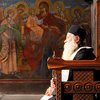Difference between revisions of "Template:Featured"
m |
(Ch. of Romania) |
||
| Line 1: | Line 1: | ||
<!--- CONTACT User:ASDamick TO GET YOUR ARTICLE FEATURED ---> | <!--- CONTACT User:ASDamick TO GET YOUR ARTICLE FEATURED ---> | ||
<div style="float:left;margin-right:0.9em;"> | <div style="float:left;margin-right:0.9em;"> | ||
| − | [[Image: | + | [[Image:Romanian_hieromonk.jpg|100px|A Romanian hieromonk]] |
| − | </div>The '''[[ | + | </div>The '''[[Church of Romania]]''' is one of the [[autocephaly|autocephalous]] Orthodox churches. The majority of Romanians in Romania by a very wide margin (about 20 million, or 86.7% of the population, according to the 2002 census data) belong to it. In terms of population, the Church of Romania is second in size only to the [[Church of Russia]]. |
| − | + | In the Romanian language it is most often known as '''Ortodoxie''', but is also sometimes known as '''Dreapta credinţă''' ("right/correct belief"—compare to Greek ''ορθοδοξια'', "straight/correct belief"). Orthodox believers are also known as '''ortodocşi''', '''dreptcredincioşi''' or '''dreptmăritori creştini'''. | |
| + | The current primate is His Beatitude [[Teoctist (Arapasu) of Romania|Teoctist (Arapaşu)]], Archbishop of Bucharest, Metropolitan of Ungro-Vlachia, and Patriarch of All Romania, ''Locum Tenens'' of Caesarea in Cappadocia. | ||
| − | '''''Recently featured:''' [[ | + | |
| + | '''''Recently featured:''' [[Ligonier Meeting]], [[Constantine the Great]]. Newly [[:Category:Featured Articles|featured articles]] are presented every '''Friday'''.'' | ||
Revision as of 10:23, March 18, 2005
The Church of Romania is one of the autocephalous Orthodox churches. The majority of Romanians in Romania by a very wide margin (about 20 million, or 86.7% of the population, according to the 2002 census data) belong to it. In terms of population, the Church of Romania is second in size only to the Church of Russia.
In the Romanian language it is most often known as Ortodoxie, but is also sometimes known as Dreapta credinţă ("right/correct belief"—compare to Greek ορθοδοξια, "straight/correct belief"). Orthodox believers are also known as ortodocşi, dreptcredincioşi or dreptmăritori creştini.
The current primate is His Beatitude Teoctist (Arapaşu), Archbishop of Bucharest, Metropolitan of Ungro-Vlachia, and Patriarch of All Romania, Locum Tenens of Caesarea in Cappadocia.
Recently featured: Ligonier Meeting, Constantine the Great. Newly featured articles are presented every Friday.
